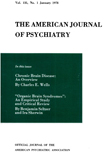Trichotillomania in Children: A Review
Abstract
Trichotillomania in children is not a common occurrence. It appears to occur more frequently in girls than in boys, however, and cuts across all ages and a wide range of nosological categories. Emotional deprivation in the maternal relationship during early years appears to contribute significantly to the development of the symptom, with the most intense conflict between the child and the original love object. Trichotillomania as a symptom may take on different meanings at different levels of development, with the original meaning becoming obscured and less significant in later years.
Access content
To read the fulltext, please use one of the options below to sign in or purchase access.- Personal login
- Institutional Login
- Sign in via OpenAthens
- Register for access
-
Please login/register if you wish to pair your device and check access availability.
Not a subscriber?
PsychiatryOnline subscription options offer access to the DSM-5 library, books, journals, CME, and patient resources. This all-in-one virtual library provides psychiatrists and mental health professionals with key resources for diagnosis, treatment, research, and professional development.
Need more help? PsychiatryOnline Customer Service may be reached by emailing [email protected] or by calling 800-368-5777 (in the U.S.) or 703-907-7322 (outside the U.S.).



